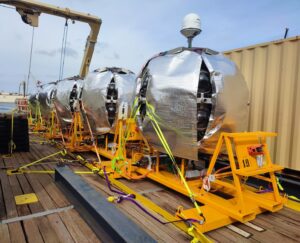ARCA enlarged with 3 new detection units!
14 September 2021 – the ARCA telescope is now enlarged with 3 new detection units.
The procedure for installing a detection unit in ARCA is as follows: firstly the detection unit is lowered from the deck of the ship. When it reaches a low level above the sea floor, the ROV (the submarine vehicle operated from the ship) comes in play: it takes a bridle and helps to guide the detection unit to its target position on the sea bottom; it also rotates it so that the panel for connection of the submarine cable faces the direction of the submarine junction box. Only at that point, the detection unit is lowered on the sea floor. After a quick visual check, the ROV detaches the deployment line. The ROV then picks up the cable which had been previously routed on the sea bottom and which is connected to the junction box on the opposite end, and plugs it to the detection unit. Then the onshore team is asked to perform a first round of test to ensure that the detection unit meets its functional requirements. After that, the ROV opens a release mechanism that lets the deployment vehicle on which the detection unit is furled free to go. The vehicle is buoyant and starts coming up; while doing so, it rotates, leaving the detection unit, which is tied to the anchor on the sea floor, upright – a sort of giant, and reversed yo-yo!
After unfurling, the deployment vehicle is recovered from the ship, to be reused for next deployments.
A final test of the newly installed and unfurled detection unit is then performed to confirm that the detection unit works as expected.
This happened three times today!













